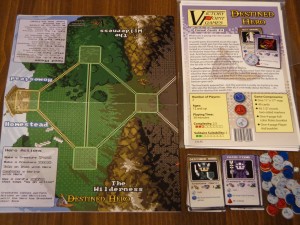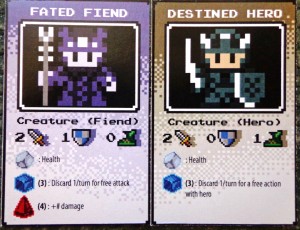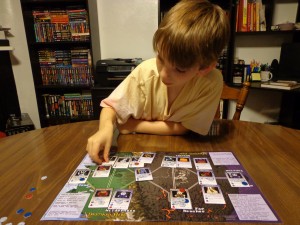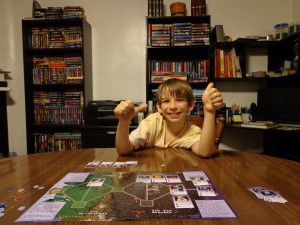Once again, the forces of evil have shown their ugly face and this time, it is up to the Destined Hero to put a stop to their plans of world domination.
In this two player game, one player controls the forces of good while the other controls the forces of evil. The forces of good will be attempting to bring their Destined Hero to the Sanctum to face and defeat the Fiend in one final epic confrontation. Before that occurs, players will be seeding the board with their own cards which will (hopefully) help their individual agendas. Let’s take a look at the game and its components, right after I shout out a quick “thank you” to Stephanie Marroquin from Victory Point Games for sending me a free copy to review.
Components
Map – The map is made up of zones , each of which has locations in which creature cards can move about.
Cards – Both players will have their own deck, which is made up of creature cards, object cards, and environment cards. They’ll be seeding the map with these cards at the beginning of the game and then be using them to try and defeat the other.
Power Tokens – Power tokens are placed on cards and do a few different things. Power tokens start out as white, which represents health (among other things), but can be traded in to upgrade the card with a blue or red token. How the upgrade affects the card is listed on the individual cards themselves.
Setup & Gameplay
The Destined Hero card is placed on the Homestead location while the Fated Fiend card is placed on the Sanctum location. Players decide who will be good and evil, and each side will receive seven random face down cards from their respective decks. The remaining cards are put aside and not used for the rest of the game.
The game takes place over three phases: the Seed Phase, the Growth Phase, and the Journey Phase. There are a lot of rules to take into consideration as the game is played, so to keep the review moving, I’ll sum up these phases and link the manual for your reading pleasure later on.
Seed Phase: During the Seed Phase, players will take turns placing all seven of their cards onto the board. While they are doing this, they’ll be placing white power tokens on eligible cards as indicated by the rules.
Growth Phase: During the Growth Phase, players will take turns upgrading their cards by turning in the appropriate number of white tokens that a card has accumulated.
Journey Phase: During the Journey Phase, players will take turns taking actions. Creature cards will be able to move, attack, use abilities, pick up items (Hero only), activate a shrine (Hero only), and gather power (Fiend only). There are limitations to what certain cards can do, depending on how far along the game has progressed. The game ends in this phase when the Destined Hero enters the Sanctum and battles the Fated Fiend…whoever wins that battle wins the game! Of course, the Destined Hero can fall before then…in which case the Fiend automatically wins.
As stated above, this is simply an overview of the game and does not cover all of the rules. Interested parties can view the manual here:
The Review
The first thing I thought when “unboxing” the game from its bag was, “Hey look, Dragon Warrior!” The cards certainly have that 8-bit charm, something retro gamers will appreciate. I also like how the map lists out the steps of the Seed Phase, as well as the actions that either side can take during the Journey Phase.
The replayability of the game is fairly high. Since twenty cards are featured in each deck and only eight of them are used (the primary character plus seven for a player’s hand), the chances of players getting the exact same cards from game to game is pretty small. This keeps every game fresh and forces players to adapt to the hand they are given. This, coupled with the different kinds of cards one can draw, creates depth that players will be exploring in order to find the best way to win the game.
Speaking of depth, the game encourages strategic play. For example, one of the Fiend’s actions is to gather power during the Journey Phase, allowing him to accumulate more white tokens. He is allowed to upgrade again right before the final battle, so the Destined Hero is up against the clock, lest the Fiend become too powerful to defeat. There’s also a lot of strategy involved during the Seed Phase, as players will need to decide where and in what order to place their cards. The order and location partially determines which cards receive the most power tokens…so players will need to weigh their options carefully and decide how best to play the hand they’ve been dealt.
My sole concern throughout the entire ordeal was how difficult the game was to learn. I had to read the manual a few times to understand the general idea behind the game, and I’m not certain that I’ve fully grasped all of the card effects and how they interact. I believe that the manual could do a better job in explaining the rules…though the player aid that came with the game helped to answer some of my questions. I don’t feel that the game’s “complexity” level of “2” was accurate…I think it should be bumped up a few notches. King’s Critters was listed as a “2.5” on the same scale and was five times easier to play. As such, I recommend this game to experienced gamers who don’t mind a learning curve. There are some casual gamers that might find this game too difficult for them, or at least, too much for them to unwind with after a tough day at the office.
All in all, it’s a fairly competent game that offers a lot to players who are willing to put the time into learning it.
Final Verdict: 5/10
You can find more information on “Destined Hero” by visiting the Victory Point Games website or on Board Game Geek, located here:




